Protecting Coral from Oil Spills and Other Hazards
From mapping and monitoring to managing reef resources and removing harmful debris, the NOAA Coral Reef Conservation Program (CRCP) supports effective management and sound science to preserve, sustain, and restore valuable coral reef ecosystems. By working across all of the NOAA offices, CRCP brings together expertise needed to take a multidisciplinary approach to managing and understanding coral reef ecosystems, to protect these beautiful and valuable underwater treasures.
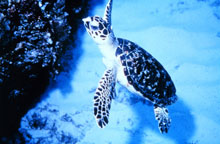
A sea turtle swims through a sea-grass meadow near coral reefs in Jobos Bay National Estuarine Research Reserve, Puerto Rico. Click image for larger view.
Imagine: you descend into clear turquoise waters, where brightly colored fish dart in and out of coral pinnacles and caves, soft coral fronds wave gently with the current, long cylindrical sponge towers loom, and flower-like anemones beckon. The shadow of a green sea turtle leisurely grazing passes overhead. Any visitor to a coral reef, even those who visit via film or television, cannot help but be entranced by these unique habitats.
Coral reefs are not only fascinating and beautiful, they are also highly productive and diverse ecosystems with environmental and economic value. Today, many coral reefs are suffering degradation due to a variety of causes, including climate change, pollutants, overfishing, development, and physical disturbances.
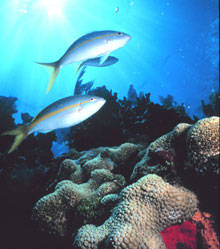
View of fish and coral from the Florida Keys National Marine Sanctuary. Click image for larger view and full caption.
NOAA works in many ways to protect coral reefs, primarily through the NOAA Coral Reef Conservation Program. This article focuses on activities designed to protect and restore reefs from the potentially devastating impacts associated with oil and chemical spills and physical damage from ships.
Oil Spills: Threats Coral Habitats
Coral habitats are extremely vulnerable to hazards posed by oil spills, and NOAA and its partners work closely together to minimize spill impacts to reef ecosystems.
Potential Spill Impacts
Oil can kill corals. The degree of damage depends on the coral species, life stage, and exposure. Branching corals, for example, are more sensitive to oil impacts than are massive or plate-like corals. In addition, the time of year when a spill occurs is critical, because coral reproduction and early life stages are particularly sensitive to oil.
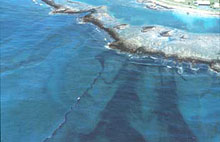
Oil slicks moving onto coral reefs at Galeta at low tide; Bahia las Minas refinery spill, Panama, April, 1986.
Corals will be affected differently depending on how they are exposed to oil. Direct oil contact is possible when surface oil is deposited on intertidal corals (corals that are exposed at low tide). Oil mixed in the water can also expose corals to harmful oil constituents. This is most likely to happen if seas are rough and the oil is a lighter, more soluble product. Subsurface oiling can smother coral if heavy oils thin out from exposure to sun and wind or if they mix with sediment and become heavy enough to sink.
Pollution, such as that associated with oil spills, can also make corals more susceptible to coral bleaching. Bleaching occurs when corals are exposed to environmental stress, such as elevated water temperatures, and expel their symbiotic algae (called zooxanthellae). Bleaching can damage or kill coral, depending on the severity and duration of the environmental stress and the sensitivity of the individual coral species. Corals can survive mild bleaching, as zooxanthellae have some ability to recover, but severe bleaching may kill nearly all the corals affected. Corals that withstand bleaching still suffer reproductive impairment, slowed growth, and a decreased ability to repair themselves.
Responding to Spills Near Reefs
Because coral reef ecosystems are fragile, NOAA is especially careful to respond appropriately to spills or potential spills near coral reefs. The goal of spill response in coral areas is the same as in any other habitat—to minimize damages caused by the accident and any associated spillage.
When a vessel is in danger of spilling oil or other chemicals, NOAA’s Office of Response and Restoration (OR&R) advises responders such as the U.S. Coast Guard of the impending danger. Timely and appropriate response actions when vessels run aground near coral reefs can prevent potential spills.
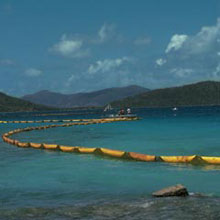
Booms like these collect and trap oil to prevent it from reaching the shoreline.
If oil is spilled near a reef, responding quickly and appropriately helps minimize damages. Most regions rely primarily on mechanical containment and recovery, such as using booms to corral the oil and skimmers to collect it, for responding to spills on the water’s surface. If the weather cooperates and equipment is available, responders may successfully prevent oil from reaching coral or other sensitive resources.
Chemical dispersants are not recommended for use directly over submerged coral reefs because this could put oil in direct contact with coral. However, if currents and water depth are conducive for carrying oil away from reefs, dispersants may be an appropriate response option to prevent oil from coming ashore and harming reefs or other sensitive habitats such as mangrove forests.
Ships Can Damage Coral Reefs
In addition to toxic impacts from spilled oil, vessel accidents can hurt coral reefs in other ways, such as physical impacts from vessel groundings, anchor damage, and release of ballast water or hazardous materials. Coral reefs are very sensitive to physical disturbances from ship groundings. The impact from grounding destroys reef structures and creates coral rubble that can do further damage when storms pound the reef. Large debris from shipwrecks or other sources can also damage reefs and removing a grounded vessel can further injure the reef.
In the event that a vessel is grounded near a reef, responders must take care to avoid physical damage to coral, especially in shallow waters. Salvage vessels that arrive to free the grounded vessel can prevent additional impact to coral by using floating lines for towing operations, carefully deploying anchors, and removing the vessel using the same pathway that it created when it hit the reef.
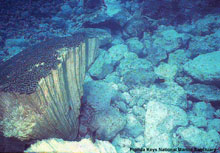
Broken brain coral and rubble resulting from a ship grounding. Click image for larger view and image credit.
In the Florida Keys National Marine Sanctuary alone, roughly 400 known vessel groundings occur each year in coral reef ecosystems, many injuring either seagrass or coral reef habitats. The OR&R Restoration and Assessment of Coral Reef Ecosystems program conducted over 135 seagrass field assessments in the sanctuary from 2000-2005, and worked to restore and monitor recovery of many of the assessed sites. Florida Keys sanctuary staff continue to assess, restore, and monitor both seagrass and coral reef injury sites in the sanctuary.
OR&R and its partners are also taking steps to prevent groundings and restore reefs that have been damaged by groundings. They have developed the National Abandoned Vessel Database of boats that could potentially threaten U.S. coral ecosystems and have removed nine grounded fishing vessels threatening coral ecosystems in American Samoa. To raise awareness about the disastrous consequences of vessel grounding on coral reefs, OR&R and partners have conducted management-focused vessel grounding workshops in Guam and Hawaii.
Taking Action to Protect Coral Reefs from Spills
Studies of the effects of oil spilled into coral habitats began in the 1960s and intensified in the 1980s. During field studies conducted after the 1986 Bahia Las Minas crude oil spill in Panama, researchers discovered that at one heavily oiled reef, total coral cover decreased by 76 percent up to 10 feet (three meters) deep.
NOAA’s Damage Assessment, Remediation, and Restoration Program

Workers clean a shoreline in Prince William Sound, Alaska, after the Exxon Valdez oil spill.
In 1989, the Exxon Valdez spilled over 10 million gallons of crude oil into Alaska’s Prince William Sound, severely affecting the rich, natural environment. It was the Exxon Valdez oil spill that indelibly marked the world’s environmental consciousness. The Valdez spill sparked Congress to enact the U.S. Oil Pollution Act of 1990.
NOAA’s Damage Assessment, Remediation, and Restoration Program (DARRP) was created in 1989 after the Exxon Valdez oil spill to provide permanent expertise within NOAA to assess injuries caused by groundings and oil spills and to work with responsible parties to restore or compensate for damages.
For the nearly two decades after its creation, DARRP has restored and protected 6,300 acres of habitat, including coral reefs, and helped generate more than $300 million for restoration in states such as Hawaii, Louisiana, and Florida, that are affected by oil spills and vessel groundings.
Coral restoration projects have successfully stabilized grounding sites by re-attaching coral rubble to prevent further damage and encourage long-term recovery of reefs. Coral transplanting from donor populations can also speed up coral recolonization.
A National Action Plan
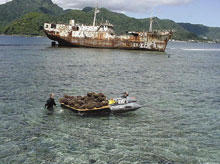
Coral transplanting as part of restoration activities in Pago Pago, American Samoa. Click image for larger view.
In 1998, in response to the continuing degradation of coral reefs from hazardous materials releases and vessel groundings, the U.S. Coral Reef Task Force was established by Executive Order. The Task Force developed, in 2000, a National Action Plan to Conserve Coral Reefs (NAP). This plan continues to serve as the nation’s blueprint for reversing the worldwide decline and loss of coral reef ecosystems.
The NAP specifically identifies the need to reduce the amounts and cumulative impacts of pollution from sources such as oil and chemical spills. The NAP also highlights the need to prevent, prepare for, and respond to oil and chemical spills as well as the need to develop, test, and enhance techniques for restoring coral reefs after they have been damaged.
Shortly after the development of the National Action Plan, the Coral Reef Conservation Act of 2000 was passed. This was the first national legislation that specifically mandated the protection of coral reef ecosystems in the U.S. Through this Act, NOAA was officially tasked with creating the Coral Reef Conservation Program, which included two coral reef grant programs to fund coral reef conservation work outside the agency.
Progress in Conserving Coral Reefs
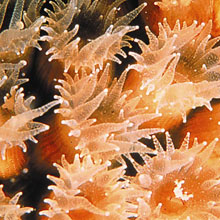
Closeup of a cavernous star coral (Montastrea cavernosa) from the Florida Keys National Marine Sanctuary. Click image for larger view.
Since the creation of the Coral Reef Conservation Program in 2001, NOAA has successfully completed a five-year effort to remove 550 tons of marine debris from the Northwestern Hawaiian Island coral reefs, expanded coral reef monitoring and assessment efforts in the U.S. Pacific, created comprehensive habitat maps of shallow coral reef ecosystems of most U.S. coral reefs, and accomplished numerous other coral restoration and monitoring tasks.
Through a combination of cutting-edge research that helps us understand the ecology of coral, on-the-ground protection, education, and intervention, NOAA is actively working to ensure that future generations will be able to enjoy coral reefs and the many fascinating plants and animals that call these habitats home.
(top)
